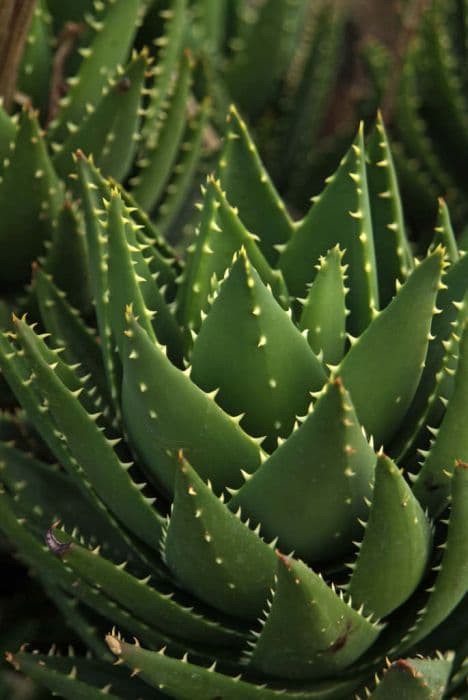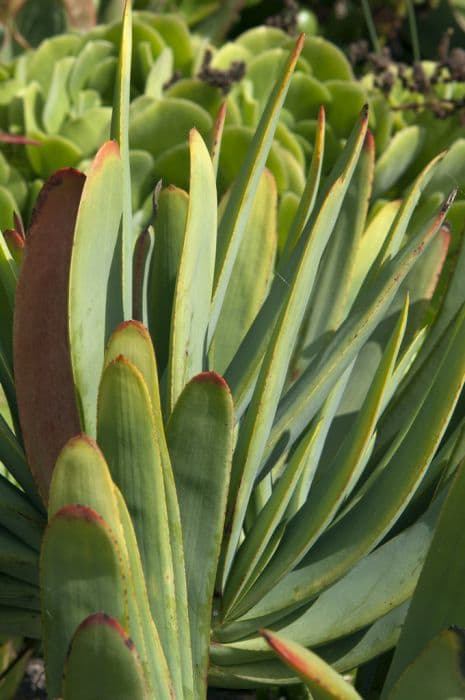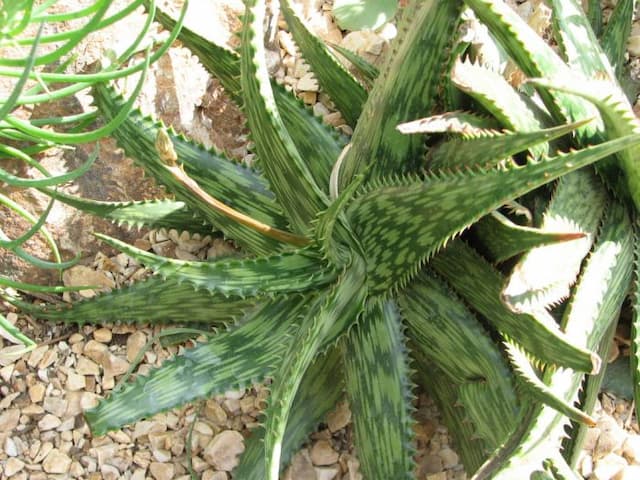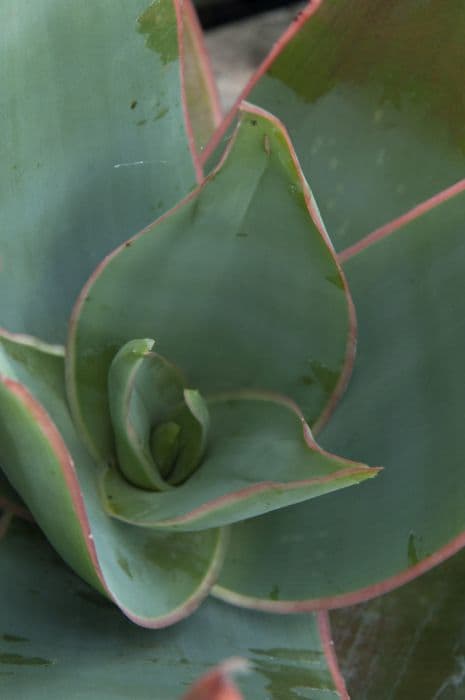Hardy Aloe Aloe striatula

ABOUT
Aloe striatula, commonly known as Hardy Aloe, is a succulent plant that is recognized for its unique and attractive appearance. This evergreen perennial sports long, slender leaves that have a green to greyish-green color, often accentuated with white spots or stripes that run parallel to the leaf margins. The leaves are arranged in rosettes, and over time, multiple rosettes may form clumps. The edges of the leaves are smooth without any thorns or spines, which is somewhat unusual for an Aloe species. During the blooming season, the Hardy Aloe produces cylindrical flower spikes that emerge from the center of the rosettes. The flowers are tubular and typically colored in shades of orange, yellow, or red, presenting a striking contrast against the green foliage. These blossoms are known to attract various pollinators such as bees and hummingbirds. The plant has a branched, shrub-like structure, making it an appealing addition to succulent gardens or as a specimen in rockeries where traditional aloes may not thrive. Its resilience and striking visual appeal make the Hardy Aloe a popular choice among garden enthusiasts seeking to add an exotic touch to their landscapes.
About this plant
 Names
NamesSynonyms
Hardy Aloe, Coral Aloe
Common names
Aloe striatula.
 Toxicity
ToxicityTo humans
The Aloe striatula, commonly known as the Hardy Aloe or Coral Aloe, is generally considered non-toxic to humans. However, it is important to note that while this aloe is safer than many other aloe species, which can contain aloin and other anthraquinones that are irritants, it still may cause mild irritation in some individuals. If the sap of the plant comes into contact with the skin, it could cause dermatitis in sensitive individuals. Ingestion is not advised, but if small amounts are accidentally ingested, it might lead to mild gastrointestinal discomfort such as nausea, diarrhea, or stomach cramps. It is always prudent to exercise caution and avoid eating or handling any plant material without proper knowledge and guidance.
To pets
The Aloe striatula, commonly known as the Hardy Aloe or Coral Aloe, is generally considered non-toxic to pets, such as dogs and cats. Unlike some other Aloe species which contain saponins and can cause adverse reactions, the Hardy Aloe is typically safer. However, caution is still advised as individual pets might react differently to plants. If a pet does ingest a portion of the plant, there might be a risk of mild gastrointestinal upset, evidenced by symptoms such as vomiting or diarrhea. It is recommended to keep an eye on your pet and consult a veterinarian if any adverse reactions occur after consuming the plant.
 Characteristics
CharacteristicsLife cycle
Perennials
Foliage type
Evergreen
Color of leaves
Green
Flower color
Yellow
Height
3-4 feet (0.9-1.2 meters)
Spread
3-4 feet (0.9-1.2 meters)
Plant type
Shrub
Hardiness zones
9
Native area
South Africa
Benefits
 General Benefits
General Benefits- Decorative: Adds aesthetic appeal to gardens and homes with its attractive foliage and structural form.
- Drought Resistance: Requires minimal watering, making it ideal for dry climates and water-conserving landscapes.
- Low Maintenance: Easy to care for, requiring little attention or special treatment.
- Cold Tolerance: More cold-hardy than many other Aloe species, allowing it to thrive in cooler climates.
- Growth Habit: Can form large clumps, making it suitable as a ground cover or border plant.
- Long Blooming Season: Produces vibrant flowers that add color to gardens for an extended period.
- Wildlife Attraction: Flowers attract pollinators like bees, which is beneficial for the local ecosystem.
 Medical Properties
Medical PropertiesThis plant is not used for medical purposes.
 Air-purifying Qualities
Air-purifying QualitiesThis plant is not specifically known for air purifying qualities.
 Other Uses
Other Uses- Aloe striatula, commonly known as the hardy aloe, can be used as a natural fence or barrier due to its dense and spiky growth habit, which can deter animals and unauthorized access to garden areas.
- The hardy aloe can be planted as part of a fire-resistant landscaping strategy; its high moisture content may help to reduce the spread of wildfires in prone areas.
- The sap of hardy aloe can be used as a natural adhesive in small-scale crafts or for minor repairs, as it becomes sticky when it dries.
- Culinary artists sometimes use the transparent and decorative leaves of the hardy aloe to add an exotic flair to gourmet dishes, despite not being widely recognized for edible use.
- Gardeners may use the hardy aloe in xeriscaping, a landscaping method that reduces the need for irrigation, since it is drought-tolerant once established.
- The flowers of the hardy aloe can be used to add a pop of color to floral arrangements or as a natural dye for fabrics and art projects.
- The architectural form of the hardy aloe makes it a popular choice for modern landscape designs, where its structured appearance can complement contemporary garden aesthetics.
- Some people use the fibrous leaves of the hardy aloe to create a rough twine or rope for gardening purposes, like tying up other plants or making trellises.
- The plant can be used in educational settings, such as schools or botanical gardens, to teach students about succulent plant adaptations and biodiversity.
- In frost-free regions, hardy aloe can be used in green roof installations, contributing to urban biodiversity and providing insulation to buildings.
Interesting Facts
 Feng Shui
Feng ShuiThe Hardya is not used in Feng Shui practice.
 Zodiac Sign Compitability
Zodiac Sign CompitabilityThe Hardya is not used in astrology practice.
 Plant Symbolism
Plant Symbolism- Healing and Protection: Aloe striatula, like other aloe species, is known for its medicinal properties, especially its ability to soothe and heal burns and skin irritations, symbolizing healing and protective qualities.
- Resilience and Adaptation: This plant can tolerate tough environmental conditions such as drought, indicating a symbol of resilience and the ability to adapt to challenging circumstances.
- Purity and Cleansing: The clear gel inside the aloe leaves is often equated with purity and is used in cleansing rituals and products.
- Beauty and Skin Care: Due to its applications in skin treatment and cosmetics, Aloe striatula is also symbolic of beauty and skin health.
- Patience and Persistence: The slow growth of Aloe striatula, coupled with its ability to thrive with minimal care, can represent patience and persistence in life.
 Water
WaterFor the Hardiness aloe, water the plant deeply but infrequently to mimic the natural arid environment it originates from. Allow the soil to dry out completely before watering again, which should generally be every 2 to 3 weeks during active growth periods. When you do water, apply water slowly at the base of the plant until it begins to run out of the drainage holes—this might amount to around half a gallon for a medium-sized pot. During the winter, reduce watering to once a month or less, depending on the ambient humidity and temperature.
 Light
LightThe Hardiness aloe thrives in bright light conditions and should be placed in a spot where it can receive at least six hours of direct sunlight daily. An ideal location would be a south or west-facing windowsill where it gets ample sun. If you're growing it outdoors, a sunny spot with some afternoon shade in extremely hot climates is perfect to prevent sunburn.
 Temperature
TemperatureHardiness aloe prefers temperatures between 50°F and 80°F but can withstand dips down to 30°F for short periods. Avoid exposure to temperatures below this as it can damage the plant. the ideal range for promoting healthy growth is from 60°F to 70°F. Always protect the plant from frost, which can be lethal.
 Pruning
PruningPruning the Hardiness aloe is generally done to remove any dead or damaged leaves and to keep the plant looking its best. Use clean, sharp scissors or pruning shears to make precise cuts. The best time to prune is in the spring or early summer, just before the plant enters its active growing phase. Pruning can also help to encourage fuller growth.
 Cleaning
CleaningAs needed
 Soil
SoilCoral Aloe prefers well-draining soil with a mix of sand, perlite, and organic matter. The best soil pH for Coral Aloe is slightly acidic to neutral, ranging from 6.0 to 7.5.
 Repotting
RepottingCoral Aloe should be repotted every two to three years to refresh the soil and accommodate root growth.
 Humidity & Misting
Humidity & MistingCoral Aloe thrives in dry conditions and does not require high humidity; average room humidity is generally adequate.
 Suitable locations
Suitable locationsIndoor
Place Coral Aloe in bright, indirect light indoors and ensure good air circulation.
Outdoor
Plant Coral Aloe in a sunny spot with well-drained soil and shelter from frost.
Hardiness zone
9-11 USDA
 Life cycle
Life cycleThe life cycle of Aloe striatula, commonly known as the Coral Aloe, starts with seed germination, which occurs readily in warm, moist soil conditions. After germination, seedlings develop into juvenile plants, establishing a rosette of fleshy, striped leaves characteristic of the species. As it matures, the Coral Aloe will develop a woody stem and can reach heights of up to 2 meters. During spring or early summer, mature plants produce tall flowering stalks with tubular yellow to orange flowers, which are pollinated by birds, bees, and other insects, leading to seed formation. After pollination and seed set, the seeds are dispersed by wind or gravity, ready to begin a new generation. Over time, Coral Aloe may also propagate vegetatively through offsets (pups) that grow at the base of the parent plant, ensuring its spread and continued survival in its native habitat.
 Propogation
PropogationPropogation time
Spring-Summer
Aloe striatula, commonly known as Coral Aloe, is typically propagated through offsets or pups, which are miniature versions of the parent plant that grow from its base. The best time to propagate Coral Aloe by pups is during the spring or early summer when the plant is actively growing. To propagate, carefully remove the pups from the parent plant, making sure each has some roots attached. Allow the cut end of the pup to callous over for a day or two to prevent rotting, which is essential for successful rooting. Once the end has dried, plant the pup in a well-draining soil mix, and water lightly until it establishes, gradually increasing watering frequency as the plant grows.









